Analyzing the Impact of Election Coverage on Public Opinion
The media plays a crucial role in shaping public opinion by presenting information and framing issues in a particular way. Through various forms of media such as news outlets, television programs, and online platforms, individuals receive messages that can influence their perceptions and beliefs. The way news is reported, the angles taken on stories, and the sources used all contribute to how the public interprets and forms opinions on different issues.
Moreover, the relationship between media and public opinion is a complex interplay of information dissemination and reception. Media outlets not only provide news and analysis but also have the power to set agendas and prioritize certain topics over others. This agenda-setting function can heavily influence what the public considers important and impacts the issues that gain widespread attention and discussion. Additionally, the way in which news is presented, including the tone, framing, and language used, can sway public opinion in varying ways.
The Influence of Biases in Election Coverage
Election coverage plays a crucial role in shaping public opinion and influencing voter decisions. However, biases in media reporting can significantly impact the portrayal of candidates and issues, ultimately swaying public perception. Biases can manifest in various forms, such as selective reporting, framing of stories, and the emphasis on certain viewpoints over others.
The presence of biases in election coverage raises concerns about the objectivity and fairness of the information presented to the public. Media outlets have the responsibility to provide accurate and unbiased coverage to ensure that voters are well-informed when making their electoral decisions. When biases are present, they can skew the public’s understanding of candidates, policies, and important issues, leading to a distorted view of the political landscape.
The Role of Social Media in Shaping Public Perception
Social media plays a significant role in shaping public perception by serving as a platform for the dissemination of information and ideas. With the ability to reach a wide audience instantaneously, social media platforms have the power to influence public opinion on various issues ranging from politics to social justice. The viral nature of content on social media allows certain narratives to gain traction and ultimately shape how individuals perceive different events or topics.
Moreover, social media has democratized the sharing of opinions, allowing individuals to voice their thoughts and engage in discussions with others from diverse backgrounds. This level of interconnectedness has made it easier for people to come across differing perspectives and sources of information, which can ultimately impact how they perceive certain issues. Additionally, social media algorithms play a role in shaping public perception by curating content based on user preferences, potentially creating echo chambers that reinforce existing beliefs and biases.
• Social media serves as a platform for the dissemination of information and ideas
• It has the power to influence public opinion on various issues
• The viral nature of content allows certain narratives to gain traction
• Social media democratizes the sharing of opinions, allowing individuals to voice their thoughts
• Interconnectedness on social media makes it easier for people to come across differing perspectives
• Social media algorithms curate content based on user preferences, potentially creating echo chambers
How does social media influence public perception?
Social media has a significant impact on shaping public opinion by providing a platform for the spread of information, the amplification of certain voices, and the creation of echo chambers where people are only exposed to like-minded viewpoints.
What role does traditional media play in shaping public perception?
Traditional media, such as newspapers and television news, also have a significant impact on public perception through their coverage of events, framing of issues, and selection of stories to highlight.
How do biases in election coverage affect public perception?
Biases in election coverage, such as favoring one candidate over another or selectively reporting on certain issues, can influence how the public perceives political candidates and their platforms.
Can social media be a tool for spreading misinformation and shaping public perception?
Yes, social media can be used to spread misinformation and propaganda, which can have a significant impact on public perception and ultimately influence people’s beliefs and behaviors.
How can individuals be more critical consumers of media and social media content?
To be more critical consumers of media and social media content, individuals should fact-check information, seek out diverse perspectives, and be aware of their own biases and how they may be influencing their perceptions.





